Zoom
Trash

Barnum effect. The tendency to interpret vague statements as meaningful statements.

These characterizations are often used by practitioners as a con-technique to convince victims that they are endowed with a paranormal gift. Because the assessment statements are so vague, people interpret their own meaning, thus the statement becomes "personal" to them. Also, individuals are more likely to accept negative assessments of themselves if they perceive the person presenting the assessment as a high-status professional. The term "Barnum effect" was coined in 1956 by psychologist Paul Meehl in his essay Wanted – A Good Cookbook, because he relates the vague personality descriptions used in certain "pseudo-successful" psychological tests to those given by showman P. T. Overview[edit] Early research[edit] In 1947, a psychologist named Ross Stagner asked a number of personnel managers to take a personality test.
On average, the students rated its accuracy as 4.30 on a scale of 0 (very poor) to 5 (excellent). C. Subjective validation. Subjective validation, sometimes called personal validation effect, is a cognitive bias by which a person will consider a statement or another piece of information to be correct if it has any personal meaning or significance to them.[1] In other words, a person whose opinion is affected by subjective validation will perceive two unrelated events (i.e., a coincidence) to be related because their personal belief demands that they be related.
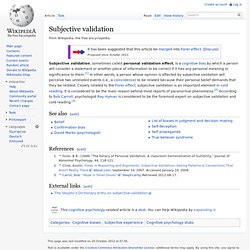
Closely related to the Forer effect, subjective validation is an important element in cold reading. It is considered to be the main reason behind most reports of paranormal phenomena.[2] According to Bob Carroll, psychologist Ray Hyman is considered to be the foremost expert on subjective validation and cold reading.[3] See also[edit] References[edit] External links[edit] Anchoring. Anchoring or focalism is a cognitive bias that describes the common human tendency to rely too heavily on the first piece of information offered (the "anchor") when making decisions.
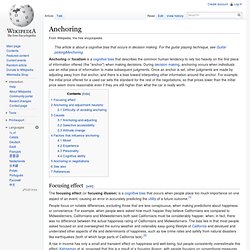
During decision making, anchoring occurs when individuals use an initial piece of information to make subsequent judgments. Once an anchor is set, other judgments are made by adjusting away from that anchor, and there is a bias toward interpreting other information around the anchor. For example, the initial price offered for a used car sets the standard for the rest of the negotiations, so that prices lower than the initial price seem more reasonable even if they are still higher than what the car is really worth.
The Narrative Fallacy: Why You Shouldn’t Copy Steve Jobs. There are dozens of blog posts about Ben Franklin’s strict daily routine (and they all almost always include this picture), advocating that we should follow suit.
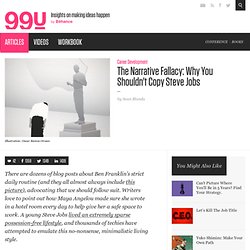
Writers love to point out how Maya Angelou made sure she wrote in a hotel room every day to help give her a safe space to work. A young Steve Jobs lived an extremely sparse possession-free lifestyle, and thousands of techies have attempted to emulate this no-nonsense, minimalistic living style. Work skills of the future: constructive uncertainty.
In recent years, science has shed a great deal of light on human cognitive bias, but, lamentably, the impacts of those breakthroughs in understanding cognition have yet to be felt in business, for the most part.

The first step for anyone who wants to counter our in-built biases is to be aware of them and take actions that will counter them, to the extent that is possible. That final proviso is based on science, again. In many cases, simply being aware of a certain sort of bias is not sufficient to counter its hold on our reasoning. Two well-known examples are sharedness bias and preference bias in group decision making (for a longer discussion, see Dissensus, not consensus, is the shorter but steeper path).
Bandwagon effect. "Cultural phenomenon" redirects here.
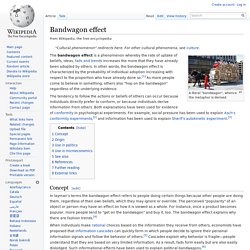
For other cultural phenomena, see culture. A literal "bandwagon", whence the metaphor is derived. The bandwagon effect is a phenomenon whereby the rate of uptake of beliefs, ideas, fads and trends increases the more that they have already been adopted by others. In other words, the bandwagon effect is characterized by the probability of individual adoption increasing with respect to the proportion who have already done so.[1] As more people come to believe in something, others also "hop on the bandwagon" regardless of the underlying evidence.
Bias blind spot. The bias blind spot is the cognitive bias of failing to compensate for one's own cognitive biases.
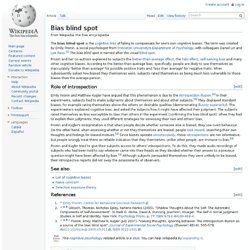
The term was created by Emily Pronin, a social psychologist from Princeton University 's Department of Psychology , with colleagues Daniel Lin and Lee Ross . [ 1 ] The bias blind spot is named after the visual blind spot . Pronin and her co-authors explained to subjects the better-than-average effect , the halo effect , self-serving bias and many other cognitive biases. According to the better-than-average bias, specifically, people are likely to see themselves as inaccurately "better than average" for possible positive traits and "less than average" for negative traits.
When subsequently asked how biased they themselves were, subjects rated themselves as being much less vulnerable to those biases than the average person. Correlation does not imply causation. The counter assumption, that correlation proves causation, is considered a questionable cause logical fallacy in that two events occurring together are taken to have a cause-and-effect relationship.

This fallacy is also known as cum hoc ergo propter hoc, Latin for "with this, therefore because of this", and "false cause". A similar fallacy, that an event that follows another was necessarily a consequence of the first event, is sometimes described as post hoc ergo propter hoc (Latin for "after this, therefore because of this"). As with any logical fallacy, identifying that the reasoning behind an argument is flawed does not imply that the resulting conclusion is false. In the instance above, if the trials had found that hormone replacement therapy caused a decrease in coronary heart disease, but not to the degree suggested by the epidemiological studies, the assumption of causality would have been correct, although the logic behind the assumption would still have been flawed.
Usage[edit] Ethnocentrism. Ethnocentrism is judging another culture solely by the values and standards of one's own culture.[1][page needed] Ethnocentric individuals judge other groups relative to their own ethnic group or culture, especially with concern for language, behavior, customs, and religion.
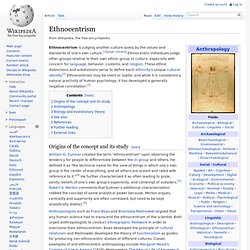
These ethnic distinctions and subdivisions serve to define each ethnicity's unique cultural identity.[2] Ethnocentrism may be overt or subtle, and while it is considered a natural proclivity of human psychology, it has developed a generally negative connotation.[3] Origins of the concept and its study[edit] William G.
Sumner created the term "ethnocentrism" upon observing the tendency for people to differentiate between the in-group and others. He defined it as "the technical name for the view of things in which one's own group is the center of everything, and all others are scaled and rated with reference to it. Normalcy bias. The normalcy bias, or normality bias, is a mental state people enter when facing a disaster.
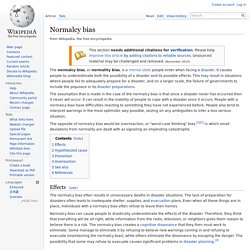
It causes people to underestimate both the possibility of a disaster and its possible effects. This may result in situations where people fail to adequately prepare for a disaster, and on a larger scale, the failure of governments to include the populace in its disaster preparations. Maes–Garreau law. The Maes–Garreau law is the statement that "most favorable predictions about future technology will fall within the Maes–Garreau point", defined as "the latest possible date a prediction can come true and still remain in the lifetime of the person making it".[1] Specifically, it relates to predictions of a technological singularity or other radical future technologies.[1] It has been referred to as a "law of human nature",[2] although Kelly's evidence is anecdotal.
The Maes-Garreau effect is contradicted by analysis of a much larger set of AI predictions of 95 predictions extracted from a database of 257 AI predictions, which finds a broad array of estimates before and after a predictor's estimated longevity.[3] Origin of the law[edit] Attentional bias. Attentional bias is an ad hoc scientific term. Attentional bias can also refer to the tendency of our perception to be affected by our recurring thoughts. [1] For example, if we think frequently about the clothes we wear, we pay more attention to the clothes of others. Decisions[edit] Availability heuristic. The availability heuristic is a mental shortcut that relies on immediate examples that come to mind. The availability heuristic operates on the notion that if something can be recalled, it must be important. Backfire effect. Choice-supportive bias. Confirmation bias. Tendency of people to favor information that confirms their beliefs or values Confirmation bias, also known as myside bias, is the tendency to search for, interpret, favor, and recall information in a way that confirms or supports one's prior beliefs or values.[1] People display this bias when they select information that supports their views, ignoring contrary information, or when they interpret ambiguous evidence as supporting their existing attitudes.
The effect is strongest for desired outcomes, for emotionally charged issues, and for deeply entrenched beliefs. Confirmation bias cannot be eliminated entirely, but it can be managed, for example, by education and training in critical thinking skills. Curse of knowledge. Decoy effect. Denomination effect. Empathy gap. Escalation of commitment. Escalation of commitment was first described by Barry M. Gambler's fallacy. Halo effect. Herd behavior. Herd behavior describes how individuals in a group can act together without planned direction.
Hyperbolic discounting. Ideomotor phenomenon. Illusion of validity. In-group favoritism. Information bias (psychology) James Randi and the Seer-Sucker Illusion. Ignorance and uncertainty. List of cognitive biases. Negativity bias. Observer-expectancy effect. Omission bias. Optimism bias. Outcome bias. Overconfidence effect. Pessimism bias. Placebo. Planning fallacy. Post-purchase rationalization. Pro-innovation bias. Procrastination. Reactance (psychology) Recency illusion. Reciprocity (social psychology) Regression fallacy. Restraint bias. Salience (neuroscience) Selective perception. Self-Enhancing Transmission Bias and Active Investing by Bing Han, David A. Hirshleifer. Status quo bias. Stereotype. Survivorship bias. The Galatea Effect:The Power of Self-expectations. The hard-easy effect for kids tactical awareness in sport. Unit bias. A new heuristic that helps explain th... [Psychol Sci. 2006.
Word Spy - frequency illusion. Zero-risk bias.